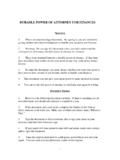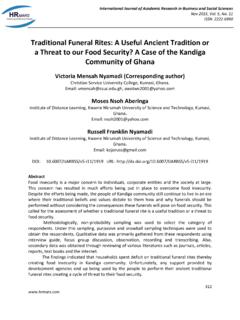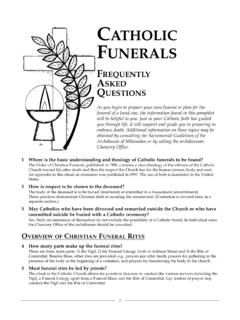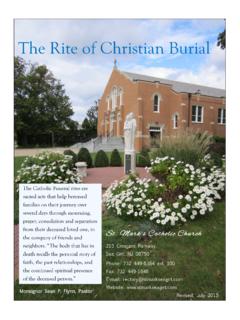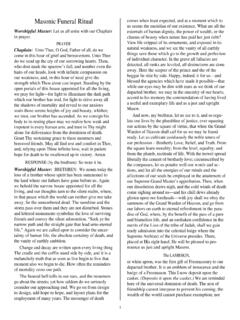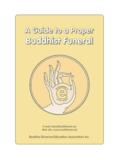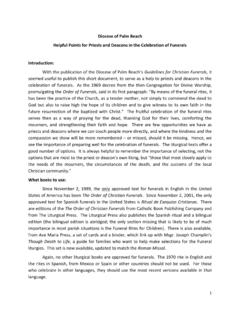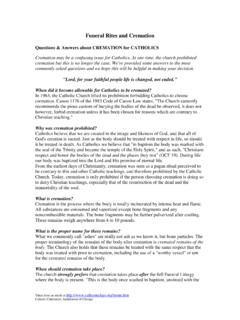Transcription of PROVINCIAL GUIDELINES FOR FUNERAL RITES
1 B-1 PROVINCIAL GUIDELINES FOR FUNERAL RITES (These GUIDELINES occupy a middle ground between the norms of the official liturgical RITES and the given pastoral situation. They seek to guide and implement good liturgical and PROVINCIAL practice, sometimes indicating a preference for certain options. The GUIDELINES give way to practical pastoral judgment in a given pastoral situation.) A. GENERAL GUIDELINES 1. The FUNERAL RITES of the church, as official Christian worship, accompany the personal and communal process of honoring the deceased person, paying final respects, expressing grief, loss, and leave-taking, as well as bonding with others, a human process with many variables. Accordingly, the various RITES of the church take place over time and should not be omitted or combined unless necessary. Among the many RITES provided in the Order of Christian Funerals, the following are more commonly provided in the situation of PROVINCIAL funerals. Greeting the body of the deceased (when the body is brought to the church or chapel).
2 Vigil Service (or wake service) FUNERAL liturgy, which is the principal celebration. (OCF, 5) Final Commendation and Farewell (usually joined to the FUNERAL liturgy) Committal Service (usually taking place at the graveside). As far as possible, the above RITES should be maintained, suitably spaced so as to give time for gathering and paying final respects. In particular, OCF notes that the vigil service should take place at a time well before the FUNERAL liturgy. (OCF,55) PROVINCIAL GUIDELINES B-2 2. The PROVINCIAL minister (or his delegate) determines the time and place of the FUNERAL RITES . The two most important services are the Vigil Service and the FUNERAL Liturgy. If at all possible, these should be celebrated on separate days. The most preferable sequence is as follows: laying out, viewing and vigil service on one day, followed by FUNERAL liturgy and burial RITES the next day.
3 Pastoral need may demand other less preferable options: Laying out in the morning, vigil service at an appropriate time, and the FUNERAL liturgy toward evening. Burial could take place the next day. Laying out (joined to the vigil service) in the afternoon, with the FUNERAL liturgy toward evening. Burial could take place the next day. 3. When possible, members of the family of origin or friends of the deceased friar ought to be included in the preparation and ministries of the FUNERAL RITES , but they should not be asked to assume any role that their grief or sense of loss may make too burdensome. (OCF, 15) PROVINCIAL GUIDELINES B-3 B. GREETING OF THE BODY OF THE DECEASED FRIAR. 1. Recalling that the present FUNERAL home developed as a replacement for waking the body of the deceased in the home, it is the custom of the province that the body of a deceased friar be laid out in a church or chapel, especially one which adjoins a friary, rather than in a FUNERAL home.
4 It is the prerogative of the PROVINCIAL minister (or his delegate) to decide otherwise in a particular situation. 2. Given this custom, the Rite of Greeting the Body of the Deceased Friar assumes more importance than in the typical parish FUNERAL , taking on aspects of the greeting at the beginning of the FUNERAL liturgy. When the body of a deceased friar is brought to the church or chapel by the FUNERAL home personnel, it should be met and greeted by those friars who can gather, as well as by family and friends. Where available, a tolling of bells can announce the arrival of the body. 3. A suitable place for the body of the deceased friar should be arranged separate from the sanctuary area, such as a gathering space or a side chapel. It should be a space appropriate for the flow of mourners and the process of visitation. The presence of the Easter candle and, if available, a font, can highlight the relationship of Christian death to baptism. Only when no other space is available is the body of the deceased friar placed near the sanctuary area.
5 4. If it is desirable to include some mementos of the deceased within the FUNERAL RITES , these can be discreetly laid out near the viewing area where people can see them at their leisure. Their inclusion in the FUNERAL RITES is not recommended. As the OCF states: Only Christian symbols may rest on or be placed near the coffin during the FUNERAL liturgy. (no. 38) 5. A lounge area with rest rooms should be available nearby, especially for family and friends. 6. It is not necessary for someone to stay with the body of the deceased friar through the night, as long as it is left in a secure place. PROVINCIAL GUIDELINES B-4 C. THE VIGIL SERVICE 1. The vigil service developed as a home prayer service rather than an official rite of the Church (OCF, 55). While it is classified as an official liturgy today, its domestic origin can speak to the manner and content of the vigil service.
6 There should be some room, as desired, for expression of our Capuchin-Franciscan heritage, testimony to the life of the friar, and family recollections. 2. The liturgy of the word is the prevailing form of vigil service used in the province. The liturgy of the hours is a possible alternative. 3. While the form of a word service does call for a homily, there is also room for elements of testimony or eulogy. Non-biblical readings can be used in support of the Word (OCF, 23). Sample services are PROVINCIAL by the PROVINCIAL liturgical commission, with encouragement to unique preparation for each FUNERAL . PROVINCIAL GUIDELINES B-5 D. THE FUNERAL LITURGY 1. When the casket is closed for the last time, it is appropriate to gather friars or relatives for a brief moment of prayer, a last paying of personal respects to the mortal remains of the deceased friar.
7 This can be conducted by the presider or another friar. 2. It is customary that members of both the Capuchin family and the family of origin take their places in the body of the church before the entrance procession begins. There is no family procession following the casket as at parish funerals. 3. The recommended procedure for the entrance RITES is as follows. It is most appropriate that the ministry (at least the presider and assistant) goes to the entrance of the church for the opening RITES . The body of the deceased friar is sprinkled with water and clothed with the FUNERAL pall before entering the assembly. The use of a font for the sprinkling is encouraged. Then the ministry, followed by the body of the deceased and the pallbearers, leads the procession to the sanctuary area during the opening song. 4. When the body of the deceased has been laid out in the sanctuary area, the opening RITES can be lead from the sanctuary area after the opening hymn. The body should be moved to a sufficiently central place if necessary.
8 6. The placing of the pall is appropriately done by family members, friends, or the minister. (OCF, 133) FUNERAL directors are usually willing to show how it is unfolded and willing to assist in the process. 7. Good liturgy calls for noble simplicity without undue repetition. The official RITES provide for possible duplication of both the sprinkling and the incensation. Recommended practice here is a reverent and deliberate sprinkling only during the opening RITES , and a reverent and deliberate incensation only at the concluding rite of commendation and farewell. PROVINCIAL GUIDELINES B-6 8. The scripture selections given in the lectionary for the vigil service and FUNERAL are not exhaustive; others can be chosen, provided that the focus is more on the mystery of Christian death than on the life of the deceased. If a Franciscan reading is desired, it can appropriately accompany the word of scripture at the vigil service, or can be read as a communion meditation during the FUNERAL liturgy.
9 9. Since the FUNERAL liturgy is most fully the expression of the church s belief in the mysteries of death and resurrection, the words of OCF 141 are particularly strong: never any kind of eulogy. If some elements of testimony to the deceased, particularly on the part of family members, are desired, and have not been incorporated sufficiently into the vigil service, a place can be found for them after communion, as long as they are suitably brief. 10. Note the careful distinction between the Rite of Final Commendation and Farewell, and the Rite of Committal. The Rite of Final Commendation and Farewell is directed to the body of the deceased, and usually takes place in church at the end of the FUNERAL liturgy. The Rite of Committal is directed to the place of burial of the remains, and usually takes place at the graveside. E. RITE OF COMMITTAL 1. There is a tendency in FUNERAL practice to relegate the burial to a private service with only immediate family members, and to make use of FUNERAL chapels rather than go to the graveside.
10 Our practice is to embrace as fully as possible the burial service as part of our Christian faith and social process. As OCF 204 notes: Whenever possible, the rite of committal is to be celebrated at the site of committal, that is, beside the open grave or place of interment, rather than at a cemetery chapel. 2. The rite of committal provides for the actual burial either during the service or at the end of the service. (OCF, 219). In case of burial during the service, this needs to be specifically arranged with the FUNERAL director. 3. In case of inclement weather, the FUNERAL RITES conclude with the final commendation in the church or chapel. The rite of committal is omitted. PROVINCIAL GUIDELINES B-7 F. FUNERAL DINNER The FUNERAL dinner is important not only for hospitality, but also to bring social closure to the whole event in a healthy way, especially the personal process of loss, grief, and leave-taking.
